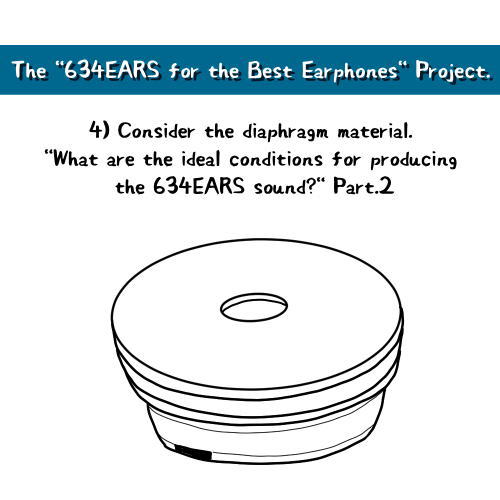I will proceed on the assumption that you have read the previous article, so please see that one if you have not yet.
1) Type of diaphragm material
There are a variety of diaphragm materials. Some are metal, some are carbon-based, and some are resinous.
634EARS has used D-type drivers with diaphragms made of various materials such as titanium, beryllium, graphene, liquid crystal polymer, and polyurethane.
Soft materials tend to deform the diaphragm, allowing for a greater range of sound adjustment, but they are prone to the flexing sound characteristic of D-type drivers when worn (a floppy sound).
To prevent this, an air hole is drilled in the front side of the D-type driver to release the pressure in the front housing, but this hole also makes it easy for bass sound to escape.
For example, LOAK uses a diaphragm made of a relatively flexible material. Therefore, the range of sound adjustment is extremely wide.
In order to produce a delicate and well-defined sound, a flexible thin diaphragm is tensioned (like a drum head being stretched tight without loosening) to simulate a rigid material that is hard to deform.
However, such usage has durability issues, and once strong pressure is applied to the diaphragm from the outside, the diaphragm is prone to breakage and flexing sound.
Harder materials are less likely to deform the diaphragm, so there is less flexing sound when worn, but the range of sound adjustment may be smaller.
For example, OBER and SARN have metal-type diaphragms made of hard materials.
However, there are many metal materials that are hard and hard to deform even when thin, which inevitably leads to a sharp, sharp, and tight sound.
Recently, there are diaphragms made of carbon-reinforced liquid crystal polymers and diamond-like carbon, and D-type drivers with diaphragms that are harder but allow a wider range of sound adjustment are also available.
2) What is the best diaphragm material?
We would like to create an upgraded model of LOAK that will be the best earphones by selecting the diaphragm made of the best material, but what is really desirable?
We have tested D-type drivers with diaphragms made of various materials, but in the end, we have not been able to determine the best material.
This is because, although there are differences in hardness, internal loss, density, etc., depending on the material, how thick the material is, and how the tension is applied, the best material for the diaphragm can be determined. How much tension is applied? This is because the Young’s modulus of the diaphragm will vary.
A hard metal material can be easily deformed if it is made thin, and a soft resin material can become like a hard material if the diaphragm is stretched tightly under tension.
However, I am currently looking for a diaphragm material that is stiffer but also more elastic than the LOAK I am currently using, because I want to produce a more responsive and delicate sound than the LOAK, and I also want to increase the movement of the diaphragm to enhance dynamics and bass (these are two contradictory requirements).
I am thinking that liquid crystal polymer and graphene are the candidates for the ones i am testing, and perhaps metal types are a little different in sound direction from what I am looking for.
Although the best diaphragm material has not been determined at this point, we have described 634EARS’ ideal requirements for the diaphragm.
Of course, the diaphragm needs to have the best acoustic characteristics.
However, a small manufacturer like 634EARS, which cannot design a completely original D-type driver, has to tune the available D-type driver to create an original sound as an earphone, so it is also necessary to determine how much the diaphragm movement can be changed.
In reality, it would be ideal to produce earphones using only original designs from the very beginning, but that is practically impossible, so we develop earphones based on the idea of creating our own original sound within the limits of what we can do.
Therefore, no matter how good the sound of a D-type driver is, if the adjustment range of the sound is very small, it will not be the sound of 634EARS but the sound of the person who made the driver, so we do not use it.
Each manufacturer has its own ideas in this area, but we at 634EARS want to be flexible in our thinking, but not lose sight of the important parts.


